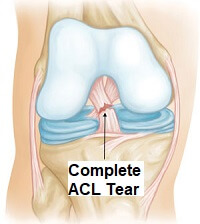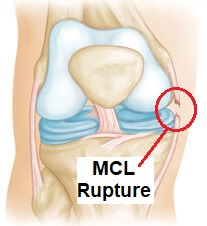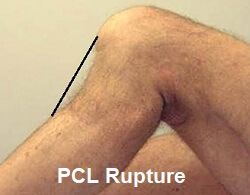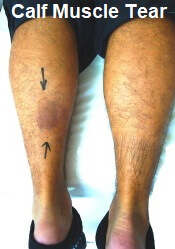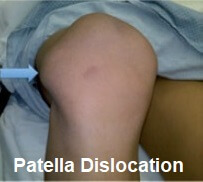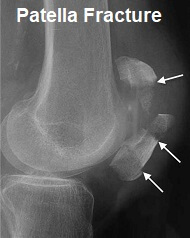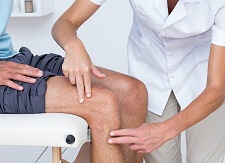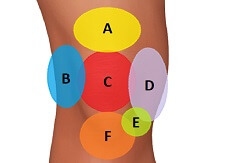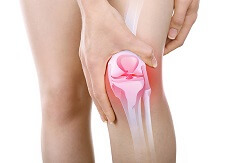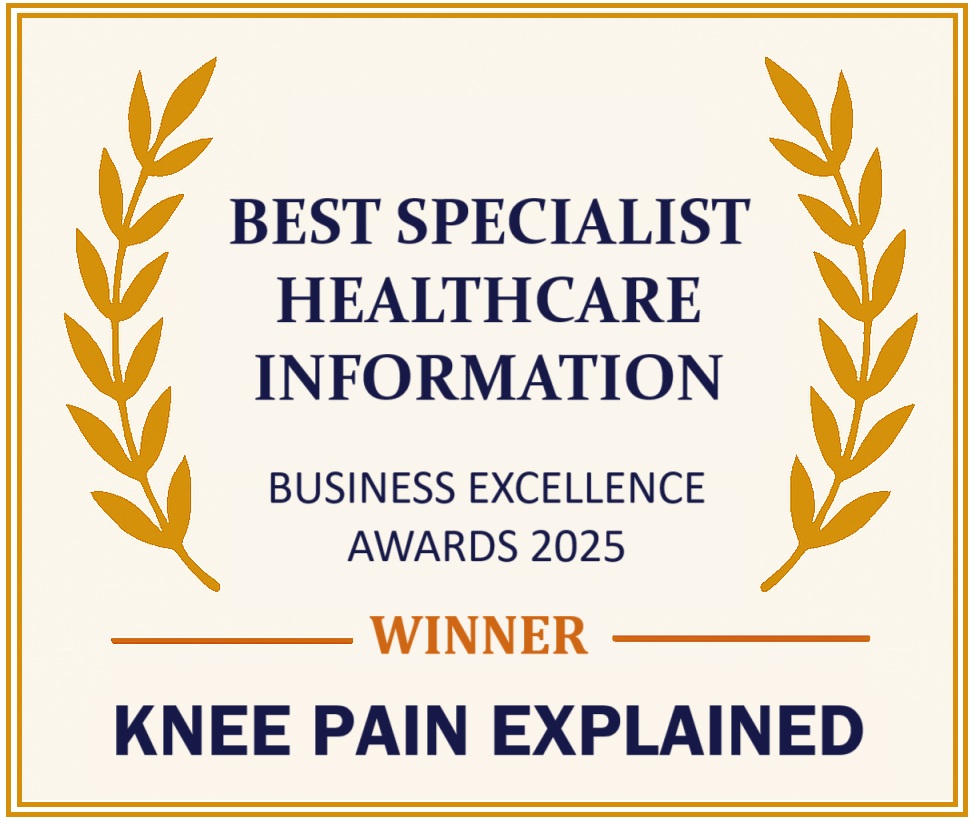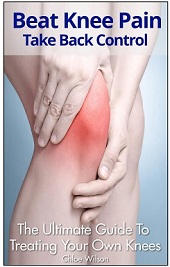- Home
- Common Knee Injuries
Common Knee Injuries
Written By: Chloe Wilson, BSc(Hons) Physiotherapy
Reviewed by: KPE Medical Review Board
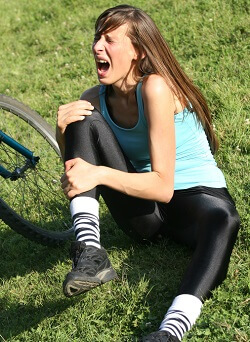
Common knee injuries vary from minor falls which may settle quickly to major accidents which may take months to recover from.
Some injuries result from strong forces going through the knee e.g. sporting tackle or fall, whereas others may be the result of simply twisting or bending slightly wrong.
The most common knee injuries fall into four groups:
Knee injuries may cause pain, swelling, instability as well as reducing movement, and may make it difficult to walk.
Common Knee Injuries Guide
Here, we look at nine of the most common knee injuries, including how they occur, the symptoms for each one and the best knee injury treatment options. The knee ligaments and cartilage are the structures most frequently damaged so we'll start with those.
Knee Ligament Injuries
Ligament injuries are the most common knee injuries in sports and can affect any of the four knee ligaments:
- ACL: anterior cruciate ligament
- PCL: posterior cruciate ligament
- LCL: lateral collateral ligament
- MCL: medial collateral ligament
The anterior cruciate ligament and posterior cruciate ligament control the forwards and backwards movement of the knee and are really important for providing stability.
The medial and lateral collateral ligaments provide sideways stability for the knee.
1. Ligament Sprains
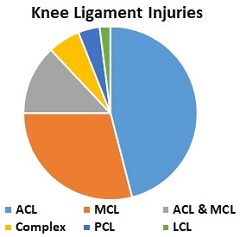
Knee sprains are one of the most common knee injuries. The term knee sprain refers to the over-stretching of any of the knee ligaments which results in tearing of some of the fibres.
Knee sprains are usually caused by:
- Sudden force through the knee e.g. sporting tackle
- Sudden twisting e.g. changing direction when running, especially when wearing cleats/stud
Common symptoms of ligament sprains include knee pain, swelling, instability and difficulty bending and straightening the knee.
Find Out More: Knee Sprains - Causes, Symptoms & Treatment
2. ACL Knee Injuries
ACL knee injuries are a common problem in sport caused by overstretching of the anterior cruciate ligament in the center of the knee.
The ACL is extremely strong, but if the knee gets bent back too far, or twists awkwardly, then the strain on the ACL can cause some of the fibres to tear, or with enough force, rupture completely.
People often report a loud popping sound when the ligament tears, similar to a gunshot and there is usually immediate knee pain and swelling. ACL tears often result in long term knee instability, especially with pivoting and twisting movements.
Depending on the severity of damage and the functional demands of the individual, then physical therapy and rehab may be sufficient, but some cases will require surgery. Find out more about the causes, symptoms and treatment options in the ACL Injuries section.
3. MCL Injuries
An MCL tear is one of the most common injuries that causes pain on the inner side of the knee. The medial collateral ligament is usually damaged by overstretching from:
- Force through the outside of the knee: e.g. sporting tackle or fall
- Sudden twisting: of the knee e.g. skiing
Typical symptoms of an MCL tear include inner knee pain, swelling, instability and difficulty bending the knee.
Most MCL tears can be treated at home, but if the ligament has torn completely, then surgery may be necessary.
Find Out More: MCL Injuries - Causes, Symptoms & Treatment
4. PCL Knee Injuries
Damage to the posterior cruciate ligament is one of the less common knee injuries, usually caused by a force through the top of the shin bone causing the knee to bend backwards e.g. car accident or fall on to a bent knee.
Unlike other common knee injuries, there may not be much pain at the time of injury and symptoms may take time to develop. Pain and swelling from a pcl injury is usually fairly mild, but there may be ongoing problems with knee instability, particularly with activities when the knee is bent e.g. stairs, problems with running.
Find Out More: PCL Injuries - Causes, Diagnosis & Treatment
Knee Cartilage Injuries
One of the most common knee injuries is damage to the knee meniscus.
The knee joint is lined with two types of cartilage, articular cartilage which lines the bones, and then a second special layer of cartilage known as the meniscus. The meniscus works like special cushioning to reduce the force going through the knee bones.
1. Meniscus Tears
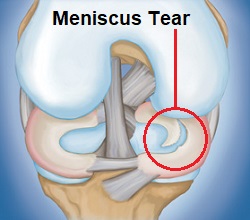
A meniscus tear is a tear in the special thick cartilage that lines the knee joint. Meniscus tears usually fall into two categories, those that occur due to:
- Injury: sudden force through the knee or sudden twisting of the knee
- Wear and Tear: gradual degeneration of the cartilage, most typically due to arthritis or a previous injury
Symptoms of meniscus tears usually include knee pain, swelling, locking, instability, difficulty straightening the knee and difficulty walking.
Meniscus tears are notoriously slow to heal due to there being a poor blood supply to the meniscus.
Find Out More: Meniscus Tears - Causes, Symptoms & Treatment
Muscle Injuries
Another group of common knee injuries is muscle damage. If the muscles around the knee are suddenly overstretched or overloaded, some or all of the muscle fibers can tear.
These are commonly referred to as muscle strains. Treated correctly, a full recovery is usually made in a few weeks, but if you try to return to strenuous activities too quickly, you are likely to suffer from long term problems.
1. Quads Strain
One of the most common knee injuries affecting the muscles at the front of the knee is a pulled quads muscle. This is where some or all of the muscles fibers in one or more of the quadriceps muscles are overloaded of overstretched and tear.
Quad strains are a common sporting knee injury typically associated with sports involving sprinting, jumping and kicking, muscle tightness, weakness and fatigue.
Typical symptoms of a pulled quads muscle include pain above the knee, thigh swelling, bruising, a "popping" sensation and difficulty walking, climbing stairs and getting in and out of a chair
You can find out more about the causes, symptoms, diagnosis and treatment options in the Pulled Quads.
2. Quads Tendon Rupture
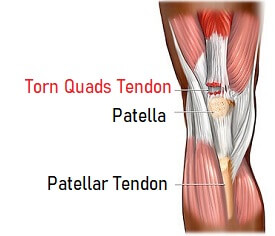
A quads tendon rupture is a serious but less common knee injury where there is a full or partial tear of the quadriceps tendon that attaches the quadriceps muscles to the kneecap
A quads rupture is typically a sporting injuries but can also be caused by a fall, twisting akwardly, tendon weakness, an underlying medical condition or from corticosteroids
Common symptoms of a quads tendon rupture include immediate pain above kneecap often with an audible "pop", limited knee extension, difficulty walking and severe swelling above the knee.
You can find out all about the causes, symptoms, diagnosis and treatment options in the Quads Tendon Rupture section.
3. Hamstring Strain
One of the most common knee injuries affecting the back of the thigh is a hamstring tear aka strain.
Hamstring strains occur when one of the hamstring muscles is suddenly overloaded or overstretched. They are one of the most common knee injuries in sport, particularly sports involving jumping, kicking, sudden acceleration or quick pivoting movements.
There are three grades of hamstring strain injury depending on how many of the muscle fibres are torn. Typical symptoms of a pulled hamstring include pain in the back of the thigh, swelling and bruising, difficulty walking and moderate to severe loss of strength.
You can find out all about the common causes, symptoms, diagnosis and treatment options in the Pulled Hamstring section, including advice on how to reduce the risk of re-injury.
4. Calf Strains
Another common knee injury affecting athletes and runners is a calf tear. This is where there is damage to some or all of the muscles fibres in one or both of the calf muscles
Calf tears are one of those knee injuries that can happen suddenly, from sudden acceleration e.g. jumping or sprinting, or may develop gradually, from repetitive overuse e.g. running
Common symptoms include calf pain, swelling, bruising, difficulty walking, and cramp
Find out how to treat and prevent common knee injuries in the calf muscles in the Calf Muscle Strain section.
Knee Cap Injuries
Damage to the patella is one of the less common knee injuries as it takes a great deal of force through the knee to damage the kneecap. As a result, they tend to be more serious knee injuries.
1. Dislocated Patella
A dislocated patella is one of the less common knee injuries where the knee cap get pushed out of place.
It takes a great deal of force to dislocate the kneecap and patellar dislocations are usually caused by a major, high impact injury e.g. car crash
Not only will the knee look deformed/out of place, it will also be extremelt painful and swollen. Occasionally you lose feeling below the knee.
Find out all about the causes, symptoms and treatment options in the dislocated patella section.
2. Patella Fractures
Patella fracture knee injuries occur when the kneecap bone breaks into two or more pieces.
Again, it takes a great force through the front of the knee for the kneecap to break e.g. falling from a height or impact from a car crash, making patella fractures one of the less common knee injuries.
There will be extreme pain and front knee swelling with a patella fracture which will limit knee movement and function.
You can find out more about the causes and treatment options in the common kneecap injuries section.
Knee Injury Diagnosis
Common knee injuries are usually diagnosed by a combination of your history, physical examination and radiographic scans.
Doctors and physical therapist can diagnose many common knee injuries from what you tell them about how you injured your knee and your symptoms, and what they can see.
In some cases, they may also send you for tests such as an x-ray or MRI scan to look directly at the bone and/or soft tissues.
Check out our knee pain diagnosis charts and hip pain location diagrams for help working out what is wrong.
Other Common Knee Injuries
As well as these nine common knee injuries there are a number of other causes of knee pain which tend to come on gradually rather than suddenly, such as:
- Tendonitis: degeneration and inflammation in the quadriceps, hamstrings or ITB tendons
- Bursitis: inflammation on one of the fluid-filled sacs (bursa) around the knee results in knee bursitis
- Arthritis: inflammation or wear and tear of the knee bones and cartilage results in knee arthritis
If you have a longer term knee condition or have been having knee pain for a while but don’t know what’s wrong, then go to the section devoted to common knee conditions.
You might also be interested in the following articles:
- Front Knee Pain
- Inner Knee Pain
- Outer Knee Pain
- Pain Behind The Knee
- Burning Knee Pain
- Knee Range Of Motion
- Knee Pain On Stairs
- Knee Pain & Popping
- Swollen Knee Treatment
Related Articles
References
1. British Journal of Sports Medicine: Injuries around the knee - Symposium. Sancheti P, Razi M, Ramanathan EBS, et al. December 2010
2. Orthopedic Journal of Sports Medicine: A Nationwide Follow-up Survey on the Effectiveness of an Implemented Neuromuscular Training Program to Reduce Acute Knee Injuries in Soccer Players. Malin Åman M, Larsén K, Forssblad M, Näsmark A, Waldén M, Hägglund M. December 2018
3. Arthritis Research & Therapy Journal: Down on one knee: soft tissue knee injuries across the lifespan. Thorlund J, Culvenor A, Ratzlaff C. December 2014
Last Updated: July 2nd, 2025
Next Review Due: July 2nd, 2027
